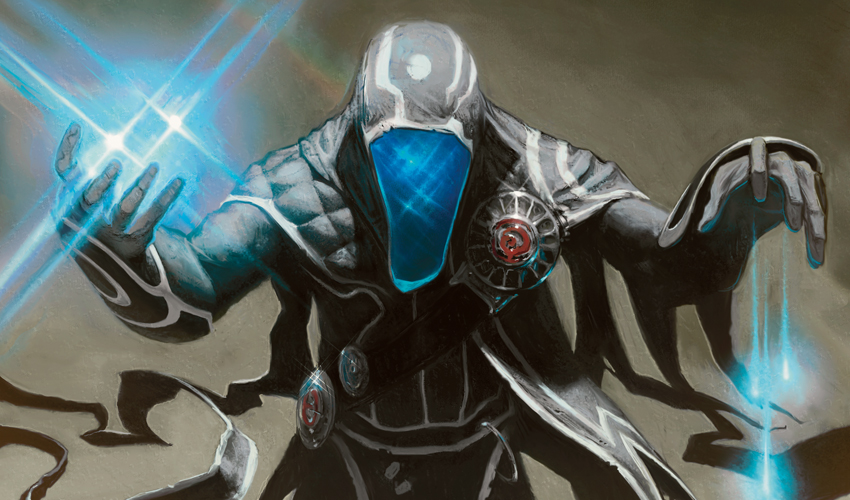Drafting Artifacts
You sit down for a Kaladesh draft, admiring the wonderful booster packs. You crack one open. Ah—time for your first choice!
You quickly narrow the pack down to these two cards. Which card is a stronger pick?
Both of these are great cards. One is a 3-power flier with haste, the other an incredible removal spell. The commonly espoused Limited strategy of taking removal early would probably tell you that Essence Extraction is a stronger card.
But which card is typically stronger isn't the question—the question is which is the better pick?
And that, wonderful reader, is what makes this interesting.

When you first-pick a card, you don't know which colors you're going to end up with.
Imagine, for a moment, that you take that Essence Extraction first. Great! But then you get passed very few black cards and have to switch out of black. Well, then that pick—your first pick!—has essentially gone down the drain.
Now, that happens all the time in drafting. After all, it is a lot better to take a first pick and move out of the color early, having the first pick "wasted" but the rest of your draft salvaged, than to clutch onto it with every fiber of your being and get to play your card, but end up with a weak deck.
But what if you didn't have to choose? What if you could just guarantee that it would end up in your final deck?
Enter: artifacts.
Stranger Things
All colorless artifacts have a secret hidden ability. It's not spelled out on the card, but it's there nonetheless. It's hidden in some liminal space between the front and the back of the card. And it's this: artifacts can always make your deck.
The secret is all in the mana symbol.

No matter what colors you end up in, you can always play your artifacts. (Verdurous Gearhulk and other unusual colored artifacts aside.) Taking one early is a safe pick: it puts a card you can always play into your deck while giving you time to see how the signals of the draft evolve.
So, you are put in a position of not just weighing the two cards against each other in a power-level sense, but in a probability-of-playing-them sense as well.
Which is a better pick: an Essence Extraction you are only going to be able to play some of the time, or a Snare Thopter you are around 100% likely to play? (You'd probably only not play it if your deck is insanely strong.)
Now we've got ourselves quite a question.
Power Versus Probability
Let's try a different example.
This time around, you open your first Kaladesh pack and you find these staring back at you as the two cards you are most likely to take:
Now, the same exact thing rings true here as before: you are very likely to play the Familiar in your final deck. You can always play the Familiar, and it'll always be fine.
The Angel has a similar concern to the Essence Extraction: it only works if you're in white, and you can't even splash it because of the double white mana in its cost.
So, from that perspective, the "likeliness to play" metric is very similar. However, the power gradient is vastly different.
Angel of Invention is an incredible mythic rare that can decide games on its own. Filigree Familiar is an entirely reasonable card to play that fits on the curve, gives you a bit of life, replaces itself when it dies, and looks incredible while doing these things.
In this case, the risk of not playing the Angel is definitely worth taking it: the strength it adds to your deck is going to be so much higher than the Familiar that you should go for it.
The inverse is true here:
Here, it's not much of a question. The artifact tends to be the stronger card already. And even if you do end up in a deck with self-bounce, the Familiar is still solid in that strategy as well. The artifact is definitely the pick; you're always going to play it, and it's generally the stronger card.
So, what does it all mean?
In a sense, the equation—an unusual solution that is both a mix of unknown probability and knowledge of card power levels—is figuring out the difference between how much more powerful the colored card is versus the artifact, and if the ability to always play that artifact is enough to overcome the difference in power level.
A tricky question indeed.
Time and Archetypes
The first pick of the draft is the time you are most unsure which colors you're going to end up in.
Every pick after the first, you have more information than before. That means that later in the draft, more can inform you about whether or not you can play a colored card. Let's return to the very first example:
If you're headed into pack three and you're firmly black-green, then you know the Essence Extraction is going to make your deck. The Thopter's "hidden power" of always making your deck is a moot point, since you know what will make your deck and what won't, and the Extraction is just as likely. At this point, you can weigh them directly against one another.
The opposite is also true: if you aren't black at all, then you know you aren't going to play the Extraction and, no matter how strong it is, it's not really something to consider for your deck any longer.
Finally, there are times where even though an artifact might be colorless, it still isn't guaranteed to make your deck. Consider this card, for example:
Now, this can certainly make any deck. It doesn't require any particular color to play or activate. However, what kind of deck does it point toward?
Unlike Snare Thopter, which is just an efficient evasive creature you'll play in basically any deck that wants 3-power fliers at a good price for Limited, Decoction Module does start to dictate what kind of deck it's good in. It's best in a slower deck that uses energy, perhaps one with some self-bounce synergies. If you take Decoction Module, and end up playing an aggressive red-white vehicle deck, there's a good chance Decoction Module will not make your deck.
Similarly, Sky Skiff is best when you're going to be playing creatures and curving out, Consulate Skygate is going to be best in a controlling deck, Metalspinner's Puzzleknot means you probably want black in your deck, and so on
Or, in short: not all artifacts are equally generic.
To figure out the question, you have to figure out how likely you are to play the artifact, too. If it takes a specific kind of deck to be able to best use the artifact, then you aren't taking a card you are always going to be able to play, and the card evaluation begins anew.
The Value of an Artifact
So, which card would I take from the beginning scenario?
I'd pick the Snare Thopter.
It's basically always going to make my deck, and while the 3 damage from Essence Extraction is great, I'd rather have the strong card I'm going to play.
And while those are all the basics, there are many other things you can start to dig into.
For example, you might believe that 3 damage is a little on the weak end in this format, since so many things make tokens and what you often have to worry about are larger creatures. You might also be thinking that several black-aligned archetypes end up with an artifact subtheme, so even if you do end up in black, having a strong artifact is still desirable. All of these different factors can start piling onto each other.
And it doesn't just stop at your first pick, either. As you keep making picks, until you really get locked into colors, the probability you'll play any individual colored card versus an artifact keeps moving. It's up to you to continue weighing them as you draft to figure out, say, if a fourth-pick artifact is going to be better than another black card when you've taken one black card already.
There's a lot to keep in mind, and a lot to practice as you begin to draft Kaladesh!
Drafting in a world of artifacts is something we haven't done for a while, so don't be afraid to take flexible artifacts early: they're always good.
If you have any thoughts on this article, or just Kaladesh in general, I'd love to hear from you! You can always reach me by sending a tweet my way, asking me a question on my Tumblr, or by emailing me at BeyondBasicsMagic@gmail.com. I'll be back again next week.
May your first picks always end up in your final deck!

